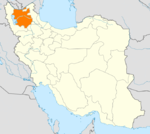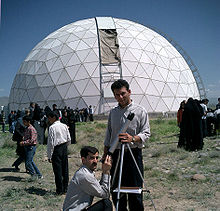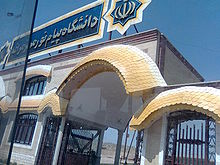- Maragheh
-
"Maraga" redirects here. For the village in Azerbaijan, see Maraga, Azerbaijan.For the administrative subdivision, see Maragheh County.
Maragheh
مراغه— city — Coordinates: 37°23′21″N 46°14′15″E / 37.38917°N 46.2375°ECoordinates: 37°23′21″N 46°14′15″E / 37.38917°N 46.2375°E Country  Iran
IranProvince East Azerbaijan County Maragheh Bakhsh Central Population (2006) - Total 146,405 Time zone IRST (UTC+3:30) - Summer (DST) IRDT (UTC+4:30) Maragheh (Persian/Azerbaijani:مراغه) also Romanized as Marāgheh and Marāghen)[1] is a city in and the capital of Maragheh County, East Azerbaijan Province, Iran. At the 2006 census, its population was 146,405, in 38,891 families.[2]
Maragheh is situated on the bank of the river Sufi Chay. The Azeri-speaking population form majority in the city. It is located 130 kilometres (81 mi) from Tabriz.
Maragheh is an ancient city situated in a narrow valley running nearly north and south at the eastern extremity of a well-cultivated plain opening towards Lake Urmia, which lies 30 km to the west. The town is encompassed by a high wall ruined in many places, and has four gates. Two stone bridges in good condition, said to have been constructed during the reign of Hulaku Khan (1217-1265), who made Maragheh the capital of the Ilkhanate. Shortly thereafter it became the seat of the Church of the East Patriarch Mar Yaballaha III. The place is surrounded by extensive vineyards and orchards, all well watered by canals led from the river, and producing great quantities of fruit. The hills west of the town consist of horizontal strata of sandstone covered with irregular pieces of basalt.
One of the famous burial towers, the Gonbad-e-Kabud (Blue Tower, 1197) is decorated with decorative patterns resembling Penrose tiles.
Its marble, which is known throughout Iran as Maragha marble, is a travertine obtained at the village of Dashkasan near Azarshahr about 50 km north-west from Maragheh. It is deposited from water, which bubbles up from a number of springs in the form of horizontal layers, which at first are thin crusts and can easily be broken, but gradually solidify and harden into blocks with a thickness of about 20 cm. It is a singularly beautiful substance, being of pink, greenish, or milk-white color, streaked with reddish copper-colored veins. It is exported and sold worldwide under such names as Azarshar Red or Yellow.
Late Miocene strata near Maragheh have produced rich harvests of vertebrate fossils for European and North American museums. A multi-national team reopened the foissil site in 2008.[3]
Contents
Maragha observatory
Main article: Maragheh observatoryOn a hill west of the town are the remains of the famous Maragheh observatory called Rasad Khaneh, constructed under the direction the Ilkhanid king, Hülagü Khan for Nasir al-Din al-Tusi. The building, which no doubt served as a citadel as well, enclosed a space of 340 by 135 meters, and the foundations of the walls were 13 to 2 meters in thickness.
Universities in Maragheh
- University of Maragheh
- Payam-e Noor University of Maragheh
- Azad University of Maragheh
Famous people born in Maragheh or who lived in Maragheh
- Bar Hebraeus
- Ala'uddin Qizil Arslan (†1191), ruler of Maragha, Nizami dedicated to him the "Haft Paikar"
- Mo'ayyeduddin Urdi (d. 1266), developed the Urdi lemma later used in the Copernican model
- Nasir al-Din al-Tusi, (born in Tus) developed the Tusi-couple later used in the Copernican model
- Najm al-Dīn al-Qazwīnī al-Kātibī (born in Qazvin) (d. 1277), described a heliocentric model
- Qutb al-Din al-Shirazi (1236-1311)(born in Shiraz) discussed the possibility of heliocentrism
- Ibn al-Shatir (1304-1375), (born in Syria) his reformation of the geocentric model was later used in the Copernican model
- Awhadi Maraghai, Persian poet (Father settled from Isfahan to Maragha)
- Ali Qushji (d. 1474) (born in Samarqand)
- Shams al-Din al-Khafri (16th century), the last major astronomer of Maragha
- Mohammad Sa'ed (1883-1973), Prime Minister of Iran
Sister cities and twin towns
References
- ^ Maragheh can be found at GEOnet Names Server, at this link, by opening the Advanced Search box, entering "-3074025" in the "Unique Feature Id" form, and clicking on "Search Database".
- ^ "Census of the Islamic Republic of Iran, 1385 (2006)" (Excel). Islamic Republic of Iran. http://www.amar.org.ir/DesktopModules/FTPManager/upload/upload2360/newjkh/newjkh/03.xls.
- ^ "International paleontologists team up for research on fossil-rich Iranian site". Mehrnews.com. http://www.mehrnews.ir/en/NewsDetail.aspx?NewsID=685698. Retrieved 18 May 2008.
- ^ http://www.bpkgo.ba/stream.php?id=821
- ^ http://www.gorazde.ba/index.php/images/vijesti/media/system/dokumenti/index.php?option=com_content&view=article&id=251:naelnik-upriliio-prijem-za-goste-iz-irana-&catid=27:vijesti&Itemid=34
- E. Makovicky (1992): 800-year-old pentagonal tiling from Maragha, Iran, and the new varieties of aperiodic tiling it inspired. In: I. Hargittai, editor: Fivefold Symmetry, pp. 67–86. World Scientific, Singapore-London
- Peter J. Lu and Paul J. Steinhardt: Decagonal and Quasi-crystalline Tilings in Medieval Islamic Architecture, Science 315 (2007) 1106-1110
External links
- Maragheh in Enc. Britannica
- The Columbia Encyclopedia
- Photography of Gunbad-i-Qabud
- Astronomy and Astrophysics Research Center of Maragha
- Biography of A'bd alqader ibn Ghaibi al Hafiz al Maraghi
- Maragheh photos
Preceded by
UrgenchCapital of Iran
1256–1265Succeeded by
Tabriz East Azerbaijan Province
East Azerbaijan ProvinceCapital 
Counties and Cities Ahar · HurandAjab Shir CountyAjab Shir · KhezerluBonabBostanabad · Tekmeh DashQarah AghajHeris CountyKaleybar CountyKaleybar · Abish AhmadKhoda Afarin CountyKhomarluMalekan · LeylanMaragheh · KharajuVarzaqan · KharvanaLandmarks
and
SightsAmir Nezam House • Arasbaran • Arg of Tabriz • Azerbaijan Museum • Babak Fort • Bazaar of Tabriz • Blue Mosque, Tabriz • Eynali • Quri-gol • Haidar Zadeh house • House of constitution • Iron Age museum • Jamee mosque of Tabriz • Kandovan • Khodaafarin Bridges • Maqbaratoshoara • Maragheh observatory • Museum of Ostad Bohtouni • Saint Stepanos Monastery • Shah-goli • Tabriz Municipality • Zahhak CastleCategories:- Maragheh
- Maragheh County
- Cities in Iran
- Cities in East Azerbaijan Province
Wikimedia Foundation. 2010.



